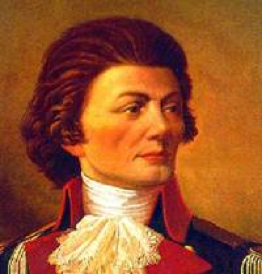
A bridge in New York City….a school in New Jersey….a town in Mississippi….even a mountain in Australia! These are only some of the things which are named for Thaddeus Kosciuszko. But really, who was this great man who is memorialized throughout the world and now stands with General Pulaski in Poland’s Peterson Park. Here is a brief summary of the life of this freedom fighter.
Thaddeus Kosciuszko was born in Poland on February 4, 1746. He attended the Cadet Academy in Warsaw before continuing his engineering studies in Paris, France. At the age of 30 Kosciuszko was a skilled engineer when he went to Philadelphia to offer George Washington his services in the struggle for freedom of the United States. On October 18, 1776 Kosciuszko was appointed an engineer by the Continental Congress and given the rank of colonel in the American Army and in 1778, he was made chief engineer of West Point, New York. This fortification became known as the American Gibraltar because it was unable to be penetrated by the British Army. For the next five years Kosciuszko provided outstanding service fortifying other battle sites, many of which became turning points in America's fight for independence against the British. In 1783, he was appointed Brigadier-General and at the end of America’s Revolutionary War Kosciuszko went home to Poland.
Inspired by America's Declaration of Independence, Kosciuszko led his own people in an unsuccessful revolution against Russia in 1794. As Commander in Chief of the National Armed Forces he defended besieged Warsaw where he was seriously wounded and taken prisoner by the Russians. He spent two years in a St. Petersburg prison. When he was released, he sailed once again for America to collect his back pay from the United States Congress. Great crowds turned out to greet this freedom fighter. He settled into a Philadelphia boarding house at the corner of Third and Pine Streets; many people came to pay their respects including Vice-President Thomas Jefferson.
After a year’s stay in the United States, Kosciuszko returned to Paris, France, and lived the next seventeen years at Berville, near Paris. It was in 1806 that Napoleon approach Kosciuszko to form a Polish Unit in the French Army. He refused and spent the last years of his life in Soleure, Switzerland, where on October 15, 1817, after a brief illness, he died at the age of 72. He is buried in Wawel Castle, in Krakow, Poland, among the tombs of the Polish Kings.
In August of 1797, Washington wrote to Kosciuszko from Mt. Vernon, stating…."I beg you to be assured that no one has higher respect and veneration for your character than I have; and no one more seriously wished, during your arduous struggle in the cause of liberty and your country, that it might be crowned with success." When Jefferson heard of his friend’s passing in 1817, he remarked that Thaddeus Kosciuszko had been…"As pure a son of Liberty as I have ever known."
Although these men are long gone, their memory remains. Kosciuszko's room in the Philadelphia boarding house has been restored to serve as our national memorial to this champion of human freedom. The National Park Service opens the boarding house to the public Wednesday to Sunday, 1 PM to 4 PM. Here you will find many exhibits, an information area and a small bookstore. A room furnished as it might have been during Thaddeus' time is located on the second floor.
